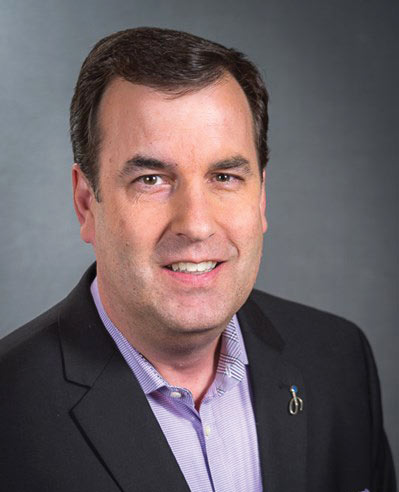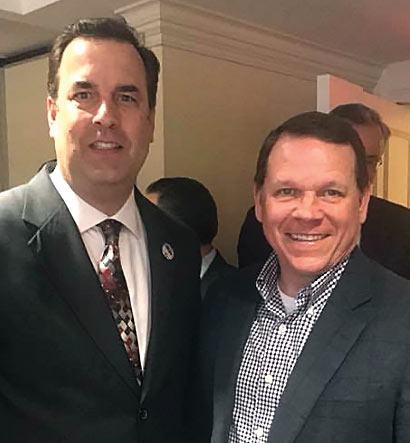 Stacy Tetschner is nearly a year into his tenure as the United Motorcoach Association’s (UMA’s) president and CEO—he officially took the reins June 5, 2017—and brings with him nearly three decades of helping, managing, and growing professional and trade associations alike. Most recently, he worked as the CEO of the Arizona-based National Speakers Association, where he demonstrated a proven track record of increasing its membership base, budget, and member engagement: “While I am new to the motorcoach industry,” he admits, “I am no stranger to working in associations.”
Stacy Tetschner is nearly a year into his tenure as the United Motorcoach Association’s (UMA’s) president and CEO—he officially took the reins June 5, 2017—and brings with him nearly three decades of helping, managing, and growing professional and trade associations alike. Most recently, he worked as the CEO of the Arizona-based National Speakers Association, where he demonstrated a proven track record of increasing its membership base, budget, and member engagement: “While I am new to the motorcoach industry,” he admits, “I am no stranger to working in associations.”
In the past year, Tetschner has seen his share of milestones with the UMA as well as enjoyed the association’s own first-time successes from a leader’s vantage point. He recently fielded some questions from CD regarding his first year at the helm of UMA, how the association can be of service to luxury ground transportation providers trying to break into the bus and motorcoach world, and his thoughts on the future.
Chauffeur Driven: What did you hope to accomplish when you began your role as UMA President & CEO?
Stacy Tetschner: I had two major goals when coming onboard at UMA: The first was to understand this landscape myself—what are the rules, regulations, and challenges our members face?
Second, I want to help enhance and build the educational capacity for the association so it can be the premier authority for education in the industry. The UMA has such a rich history in the bus and motorcoach industry: It not only works to protect our operators from unnecessary rules and regulations, but also educates them on how to navigate the regulatory landscape as well as the business landscape so they can build a strong and thriving business. Our team is continually working to enhance all of our products and services to meet this goal; over the next year, you will see many of the fruits of their labors come to life.
CD: What have been the highlights of the past year?
ST: It has truly been a year of numerous highlights, and I am just elated with how the industry has embraced and welcomed me; however, two moments stand out among the others.
First was experiencing UMA’s Motorcoach Expo live and in-person. This trade show brings a combination of industry highlights, celebrations, the latest industry equipment and services, and a sense of family—everyone is in this for the success of each other. This is a signature event for anyone wanting to be a part of the industry and wanting to build a network: I met so many amazing people there.
The second highlight was seeing firsthand how the entire industry came together to have one voice on Capitol Hill for our legislative fly-in last month. This is a very fragmented industry with a variety of different groups and many who have traditionally scheduled their own time for legislative meetings. Having a first-ever joint fly-in with nearly 120 attendees yielded the largest effort ever for our industry. We all found that even though we represent different segments, there is common ground that we all agree on—and we can be much more powerful together than each fighting for our own segment.
CD: How can UMA help sedan operators prepare for transitioning into the bus and motorcoach world?
ST: With UMA’s dedication to protecting and promoting the motorcoach industry, we are uniquely positioned to help any new entrant navigate safety and compliance issues, understand regulations and audits that can affect their ability to operate, and provide education that helps better understand the landscape of the industry.
To help new entrants to the bus and motorcoach industry make the transition more easily, the UMA is providing its New Operators Guide to Chauffeur Driven readers free of charge. You can request it by visiting uma.org/cd.In fact, to help in that understanding, we have put together a New Operators Guide for the Motorcoach Industry that we will provide to Chauffeur Driven readers at no charge. They can request it at uma.org/cd. We hope this demonstrates our commitment to helping sedan operators make the transition more easily. An educated and informed operator base is a priority for UMA.
CD: What was the first-ever combined Fly-In Days event with the ABA like? What were the associations’ focuses when meeting with representatives this year?
ST: As I mentioned before, this was truly a highlight for me. ABA President & CEO Peter Pantuso and I meet on a regular basis to discuss industry issues: It was at one of these meetings that we were able to hatch the idea of a joint legislative fly-in. We were able to undertake an agenda with our congressional leaders that were common among all our industry groups and included two general areas of safety/regulatory reform and funding for infrastructure.
Specific conversations with our legislators included:
1. Requiring separate and distinct impact analysis, including cost-benefit analysis, on commercial passenger carriers for rulemakings at the Department of Transportation proposed to affect both trucks and buses. In essence, we want to have buses recognized separately in rules and regulations from trucks/trucking industry.
2. Requiring expanded certification to the Federal Transit Administration from public transit operators that receive federal funds to meet existing requirements on private sector engagement in transit service.
3. Improving transparency requirements for the Federal Transit Administration’s 5311(f) intercity bus grant program.
4. Preserving existing partial federal fuel tax exemption for motorcoaches.
 Tetschner (left) with U.S. Representative Sam Graves (R-Mo.) at last month’s joint UMA and ABA Fly-In Days
CD: Let’s talk ELDs. What’s the practical application versus the theoretical implication? Has there been any resistance to them? What have the biggest surprises been?
Tetschner (left) with U.S. Representative Sam Graves (R-Mo.) at last month’s joint UMA and ABA Fly-In Days
CD: Let’s talk ELDs. What’s the practical application versus the theoretical implication? Has there been any resistance to them? What have the biggest surprises been?
ST: We are approaching the five-month mark on ELDs. Initially, there was resistance from some operators simply because they were not sure what it would mean, how regulators may use them, etc.
However, we have seen the technology of ELDs continue to evolve to make these not only a compliance tool, but also a management tool that takes advantage of technology. I have spoken to operators who have said ELDs have improved their record keeping and made record storage easier, and continue to give them better insight into how their coaches are being utilized.
As with any change (especially a technological one), it is a whole new way of thinking; now that the industry has experienced it, the initial feedback is allowing ELD providers insight into making adjustments. The biggest challenge is making sure once an ELD has been selected that it works with their systems, since some ELDs were designed for truck drivers rather than motorcoach drivers. Some operators made an initial selection and found out that they may not have chosen the best model for how either they or their drivers work.
CD: What’s the biggest challenge currently facing bus and motorcoach operators, and what is the UMA’s role in supporting and educating them to navigate it?
ST: The biggest challenge we continue to see is the driver shortage. None of us has completely figured it out yet, but as we do, we are sharing those successes and best practices so we can all learn. This is especially important for operators new to larger vehicles who will need drivers with expanded qualifications.
There is common ground that we all agree on—and we can be much more powerful together than each fighting for our own segment.Additionally, new rules and regulations can also create challenges that make it tougher and tougher to operate. UMA is 100-percent committed to safety—and our industry is THE safest mode of passenger transportation available. As such, we need to ensure that we evaluate each new proposed regulation on the merits of the impact it will truly have on safety improvement against how it can potentially put an operator out of business. UMA is committed to this level of both protection and promotion of our industry. A safe and viable private motorcoach industry is a benefit to the traveling public and the economy.
CD: Where do you see this facet of the ground transportation industry heading in the future?
ST: The technology landscape continues to change and it is having a sizable impact on our industry. We have already seen it with ELDs. We are now seeing the introduction and use of battery-operated buses, and technology is allowing coaches to travel farther and farther on a single charge. European cities are already beginning to ban diesel buses in some of their cities in lieu of battery-operated transportation. And still to come will be how driverless technology could affect how our operators move passengers in the future. This technology is so new, we still don’t have all the data on it and we are continuing to monitor and share it. These are all issues we will be addressing in education and in displays are our trade show in Ft. Lauderdale next year. [CD0518]

